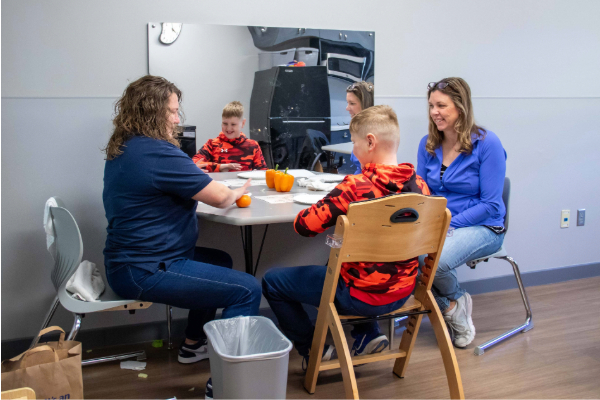3 MIN READ
Transformation at Heartspring: Luka’s Story

When Luka was younger, he would stand with his back against a kitchen cabinet and kick backward to knock out the panel.
“And once his foot went through, he would move on to the next one,” recalled his mother, Lara. “So he destroyed every cabinet in the kitchen, and by the time he went to Heartspring, he was working on the oven and the dishwasher.”
Luka is autistic with high support needs and came to live at Heartspring shortly before he turned 8 years old.
By that time, even though Lara played referee all day to minimize Luka’s destructiveness, their small home in suburban Chicago also featured a cracked ceiling and a demolished closet in the entryway.
Luka had punched a hole in his bedroom wall (eating the drywall), and he had kicked the glass patio doors so hard that Lara had to duct tape the gap to keep out the winter chill.
Luka left Heartspring in August, and at 22 years old is comfortably resettled in a four-bedroom house not far from where he lived as a child. Operated by a nonprofit that serves adults with severe developmental disabilities, the Evanston, Illinois, home has one staff member for the four residents.
Luka has the entire basement to himself, with space for his computer, TV, and Papasan chair.
“He's unrecognizable from the person he was when he enrolled at Heartspring,” Lara said. “And it's not just the age difference.”
The story of Luka’s transformation at Heartspring also features Lara’s resilience.
Retired from a nearly 30-year career as a flight attendant, Lara, 56, now lives in Austin, Texas. Luka is part of a blended family that includes six boys.
She and her first husband divorced after 10 years amidst the strain of raising Luka along with their three other boys; paying for Luka’s care bankrupted the couple.
Lara is certain that the difficulties of raising the four boys ultimately led her ex-husband to take his own life.
But even with all that stress, it still took her sister-in-law, mother, and finally, Luka’s trusted developmental neurologist to convince Lara that it was time to place Luka in a residential setting outside the home — both for his sake and for the sake of the brothers she would now have more time to raise.
She had to overcome the guilt of turning her son over to someone else to raise and realize that living almost as a prisoner in her own home for seven years had made her lose sight of what a normal life looked like.
Lara looked at nearly 20 residential options inside and outside Illinois before walking into Heartspring and knowing instantly that it was the right fit.
She noticed that, just like her, the Heartspring staff talked to the nonverbal residents. To her that indicated that staff treated the residents simply as individuals who happened to have a disability.
Plus, they taught Luka how to use the toilet in about three months — something Lara had been trying to do for years.
Outsiders might wrongly assume that a residential setting inevitably restricts the freedom of its students, Lara said. “A congregant setting like Heartspring for Luka is where he had the most freedom in his life because he was in a safe space and he had options,” she said.
He was free to ride his bike and explore the campus.
When Luka first came to Heartspring, he was averaging about 2,000 instances of destruction a month. But thanks to the calming methods he learned at Heartspring, he is now down to about five a month. That level and the fact that he is toilet trained allowed him to move into the home in Evanston.
Lara and her husband have a condo nearby, so they go up and see Luka often. As for the future, Lara’s hopes and dreams for Luka are pretty simple.
“I just want him to be happy and safe,” she said.




